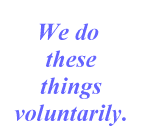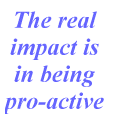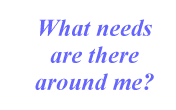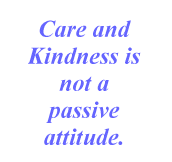The Vision Comes ALIVE!
—— Craig Bourne
'Care and
Kindness' is an active concept. When we become
pro-active in applying this vision, we discover opportunities
that make a difference in the world around us.
To some, the message of Care and Kindness is a fairly passive concept. It is warm fuzzies — it is smiling at people, being nice to them, perhaps even being a better listener. They take a fairly “passive” position in applying their idea of providing acts of Care and Kindness. We might describe their position as one primarily of ‘an attitude’ that they can accept when they are in the mood or when they have time.
 To
others, the real impact of Care and Kindness is in being pro-active —
taking actions that will benefit others; actions that are a choice for
them. They consider that ‘doing an act of Care and Kindness’
is just that — an action! Taking action that is neither required
nor even expected is truly a way of showing kindness. Looking for
a way to do something that will benefit and impact other people for good
is truly ‘caring’.
To
others, the real impact of Care and Kindness is in being pro-active —
taking actions that will benefit others; actions that are a choice for
them. They consider that ‘doing an act of Care and Kindness’
is just that — an action! Taking action that is neither required
nor even expected is truly a way of showing kindness. Looking for
a way to do something that will benefit and impact other people for good
is truly ‘caring’.
There are many organizations that are operating under this philosophy of Care and Kindness. A major one that comes to mind is Habitat for Humanity. They are building houses for people who need them simply because they are needed. How many other organizations can you think of that operate under this principle? We must thank God for the work they are doing.
Unfortunately, when we are too slow to see the need or to take the necessary steps, the government steps in and tells us that we are going to HAVE to do it.
 Example:
For how many years did people in wheelchairs face the difficulty of entering
public buildings and businesses that had stairs? How many times were they
prevented from entering because there was no way for them to get their
wheelchairs up the stairs — no ramp, no elevator, no alternatives?
Example:
For how many years did people in wheelchairs face the difficulty of entering
public buildings and businesses that had stairs? How many times were they
prevented from entering because there was no way for them to get their
wheelchairs up the stairs — no ramp, no elevator, no alternatives?
Then a series of laws were enacted that made it a requirement that buildings with steps must also provide a wheelchair ramp.
At that point, under penalty of law, ramps were installed at the front of buildings. Sloped areas were cut into street curbs at the crosswalks.
The question to ask is: Why was it necessary for us to be forced to do something that was needed — something that would help a number of other people.
 An
individual or an organization would have demonstrated the true philosophy
of Care and Kindness if they had chosen to install wheelchair ramps BEFORE
they were required. They would have taken action when they woke up to
a need that existed.
An
individual or an organization would have demonstrated the true philosophy
of Care and Kindness if they had chosen to install wheelchair ramps BEFORE
they were required. They would have taken action when they woke up to
a need that existed.
True, it would have cost them money that they didn’t have to spend. At least not yet! But when the law required these changes, the money had to be spent anyway, so financial cost isn’t a fair consideration.
People who adopt an attitude of Care and Kindness take actions that they don’t HAVE to take.
 Another
example: Many laws have been enacted in an effort to prevent
acts of discrimination because of racial differences. In this broad view
of Care and Kindness, such laws would not be necessary — people would
see each other as fellow inhabitants of the same earth.
Another
example: Many laws have been enacted in an effort to prevent
acts of discrimination because of racial differences. In this broad view
of Care and Kindness, such laws would not be necessary — people would
see each other as fellow inhabitants of the same earth.
The key question each of us can ask ourselves is: What am I doing that exhibits Care and Kindness? What can I do to help others in ways that I don’t have to? What needs are there around me that I can work towards fulfilling that are not yet required by law, code, penalty, etc.?
We can’t leave it to others. It is easy to applaud Habitat for Humanity, but it is much harder to take action on our own. Becoming pro-active can cost us time, energy, money . . . , but we choose to do it because we understand the vision of Care and Kindness.
To Christian groups, the message is this: “These are the ways that we demonstrate our faith. This is how we put our faith into action. We show our love for God by doing things that help other people for His glory. We do these things voluntarily, without waiting until we are required to do them.”
 To
secular groups, the message might be stated differently: “Showing
acts of Care and Kindness is a way of giving back to society. Society
(whether through friends and community or through government) has provided
each of us with much to be thankful for and we have an obligation to give
something back in return. Adopting an attitude of Care and Kindness makes
us a better person and provides a means for us to partially repay our
debt to society.”
To
secular groups, the message might be stated differently: “Showing
acts of Care and Kindness is a way of giving back to society. Society
(whether through friends and community or through government) has provided
each of us with much to be thankful for and we have an obligation to give
something back in return. Adopting an attitude of Care and Kindness makes
us a better person and provides a means for us to partially repay our
debt to society.”
Care and Kindness is not a passive attitude; it is not merely a warm fuzzy; it is not simply being a nice person.
Care and Kindness is a pro-active position
and
a pro-active attitude that we take.
Look around and see where there are needs that are not being met — needs that are not yet being addressed by law.
What can you do that will help others
instead of waiting for
a law that might REQUIRE it to be done?